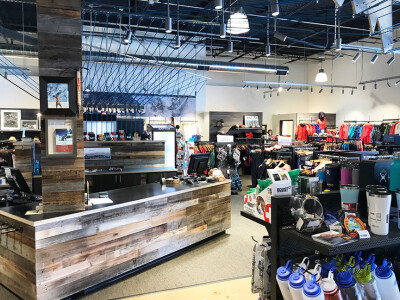It is no secret that running brands are making significant efforts to make their manufacturing process and products more sustainable, but that effort can easily extend into the run specialty stores that sell their products. There are many ways running stores can incorporate sustainability into their design and buildout without breaking the bank.
Not planning a full remodel soon? No worries — many of these ideas are easy to execute, so you can create a list of sustainable goals and chip away at them over time.
1. Start with Shopping Bags and Packaging
A simple place to start is with your shopping bags. Are they FSC-certified? (This stands for the Forest Stewardship Council, which ensures sustainable forestry practices.) If you’re using paper bags, make sure they’re made from responsibly sourced materials. Better yet, go bag-free and offer a small discount for customers who bring their own.
Another great option is investing in reusable fabric bags — they cost more upfront but become a long-term marketing tool as customers carry them around. Find some great eco-friendly bag options at www.ecopackables.com/pages/retail-bags.
To further promote sustainability, push your vendors to rethink packaging. If they’re still using plastic or non-recycled materials, speak up. Encourage them to switch to biodegradable, compostable or recyclable options whenever possible. Also, consider creating a green loyalty program where customers earn rewards for bringing their own bags, recycling some gear or arriving by bike, foot or public transit.
2. Upcycling AND Donation PrograMs
Many running stores already participate in shoe reuse programs, which is a great start. Getting creative with the collection bin can catch your customers’ eyes and encourage more participation.
In addition to old shoes, gathering jackets or running shorts for donations to underserved community run programs can be a great way to take upcycling to the next step.
3. Sustainable Store Updates and Remodels
If you’re considering doing some store updates or a remodel, consider sustainable flooring and wall covering options. Cork or recycled rubber flooring both offer durable, sustainable options that are also comfortable for your staff during long shifts. Reclaimed or FSC-Certified wood flooring will also ensure your flooring selection was sourced responsibly. Using old fence or barn wood planks to cover walls, wrap cash wrap counters or build fixtures and display tables is a great way to save money on materials and to repurpose existing and often beautiful materials along the way.
We have used some beautiful old snow fencing from Wyoming on several cash wraps in recent store designs. These types of features not only create an impactful store element, they also catch the eye of your customers and make for great conversation pieces.
Another great way to connect with your community, support local art and encourage sustainability while you’re at it is to collaborate with local artists to create some unique art focal pieces in your store made from recycled materials such as old shoes, race medals or race numbers.
And, if you have to use new materials for certain aspects, be sure to source locally in order to reduce your carbon footprint on the shipping. Also, remember to choose building material vendors who align with eco-conscious values whenever possible.
When considering new or replacing existing lighting in your store, be sure to incorporate LED lighting, as it uses up to 75 percent less energy and lasts significantly longer than traditional bulbs. Other ideas to consider for energy savings in your lighting plan include:
• Maximizing natural light by incorporating large windows or skylights whenever possible.
• Install motion sensors and timers in stockrooms and restrooms to cut energy use significantly
• Installing low-flow fixtures in bathrooms can also help on saving water.
4. Biophilic Design AND Air Quality
Bringing natural elements into your store can create a more inviting atmosphere, while also improving air quality. A living wall or a few strategically placed plants add a biophilic design element that makes the store feel fresh and vibrant and also warms up the area. VOC-free paints and finishes also help reduce harmful chemicals for better indoor air quality.
5. Sustainability in Employee Spaces
When assessing the eco-friendly level of your store, don’t forget about the backroom and employee areas. Do you have recycling and composting bins set up? Are you encouraging refilling water over single-use plastics by having filtered water stations for staff as well as out front for customers?
Years ago, when I worked at Pearl Izumi we had a “one less car” incentive program that allowed employees to earn credit toward free gear for every time they rode their bike to work. As you can imagine, in Boulder, CO, with a bunch of cycling enthusiast employees, it was a widely popular program that often left a very empty parking lot out front.
Implementing a similar program can be a fun way to motivate employees to walk, run, carpool, bike or bus to work instead of driving. It’s fun to create competitions along the way as well, with bigger prize incentives for best monthly commuter, etc.
Small Steps, Big Impact
Whatever path you take toward making your store more sustainable, the key is to start small and build momentum. Employees should be informed and engaged in the process, helping customers understand your commitment to sustainability.
People often underestimate the impact of small, consistent changes. But over time, they add up. I know the big picture of it all can get overwhelming, so I suggest picking one idea per month to implement — by the end of the year your store’s carbon footprint will be significantly lower.
Sustainability isn’t just good for the planet — it’s also a great way to differentiate your store, connect with customers and inspire positive change in your community. Ready to get started?
about the author
Holly Wiese owns 3 Dots Design, a retail consulting firm specializing in the specialty run channel. www.3dotsdesign.com






